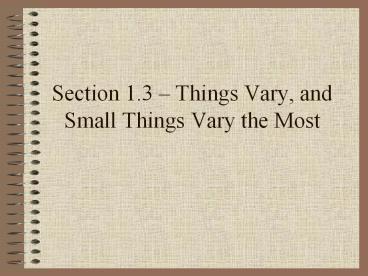Section%201.3%20 - PowerPoint PPT Presentation
Title:
Section%201.3%20
Description:
Section 1.3 Things Vary, and Small Things Vary the Most Population vs. Sample A sample is a part of the population that we actually examine to gather information ... – PowerPoint PPT presentation
Number of Views:112
Avg rating:3.0/5.0
Title: Section%201.3%20
1
Section 1.3 Things Vary, and Small Things Vary
the Most
2
Population vs. Sample
- A sample is a part of the population that we
actually examine to gather information about the
whole.
3
Example
- A sociologist is interested in determining the
percentage of college students who have smoked
marijuana so she randomly samples 50 college
students and finds that 60 of the students in
the sample respond yes. - Population All college students.
- Sample 50 college students surveyed.
4
Sampling Variability
- How confident can we be that the sociologists
estimate reflects ALL college students? - _____________________________________
- Assume the sample is randomly selected .
- The main question we need to understand is how
does the sample proportion vary in repeated
samples?
5
Well Use Simulation to Answer this Question
- Suppose we are interested in estimating the
proportion of heads that would land if a penny
was flipped a large number of times. - Population All pennies
- Population proportion of interest percentage of
coins that lands heads up.
6
How do we estimate this quantity?
- Randomly sample 25 pennies from the population of
all pennies. - Compute the proportion of heads, ,
- in the sample.
7
Student Activity
- Each person will flip a coin 25 times, keeping
track of the proportion of heads in 25 tosses. - Before doing the experiment, can you say for
- certain what your will be? What can you
say about the class data? - Consider the following example
8
Individual Student Worksheet
Flip number (n) Head landed? number of heads in n tosses Proportion of heads in n tosses
1 Yes 1 1.00
2 Yes 2 1.00
3 No 2 0.67
25 Yes
9
Percentage of Heads in n tosses
100
of heads in n tosses
10
25
n (number of tosses)
10
Law of Large Numbers
- As the sample gets larger, the proportion of each
type of event tends to move toward the
probability of that type of event occurring on
each trial. - What does this mean in terms of the penny example?
11
Gamblers Fallacy
- Common misconception about the Law of Large
Numbers - Gamblers Fallacy After several appearances of
a chance outcome, that outcome is less likely. - ex. Flip a coin 4 times and get T, T, T, T.
Gamblers Fallacy says that youre more likely to
get a H on the next flip.
12
Final Points
- Small samples vary more.
- Extreme samples tend to be small samples.
- Things vary.































